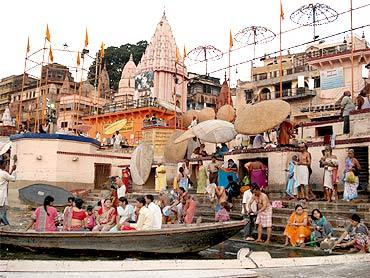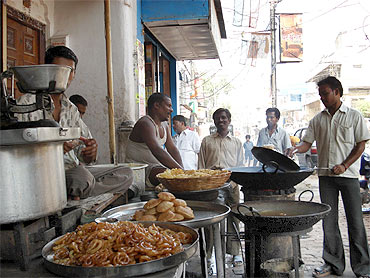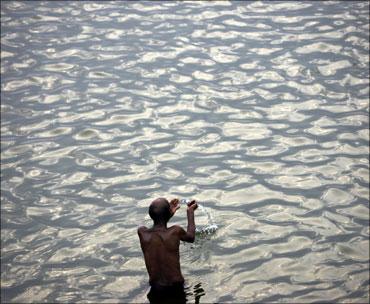Photographs: Seema Pant/Rediff.com Aditi Phadnis in New Delhi
Aditi Phadnis travels through Banaras and Lucknow and marvels at the people and the culture, especially the food, in the two cities
It isn't easy to find the soul of Banaras: but you can catch a glimpse of it along the ghats very early in the morning in the songs of the mallahs. Mallahs are the boatmen who own the Ganga. If you're a true Banarasi you will never, ever call a boat a nao. It is always bajra. Not only do the mallahs ply the bajra, they also control all trade on the ghat: the sale of sand on the banks and the elements necessary for puja: sindur, oil, akshat, vegetable and fruit that has to be immersed in the Ganga after a bath; and, of course, the tariff for the bajra ride.
Every mallah knows how to sing. So at 5 am, when the pearly dawn is just breaking, you can hear many songs on the ghats: there's M S Subbalakshmi going viral in her Vishnu Sahasranamam CD; one mallah is singing the Kabir bhajan steeped in mysticism, originally sung so evocatively by Kumar Gandharva -- kauno thagwa nagariya lootal ho.
The bhajan is about Banaras's Manikarnika Ghat, he will tell you, designated as the ghat for cremations where you bid your final goodbyes to this world to enter another, better one. Another is singing Raag Bhairavi while ferrying a boatful of sleepy Japanese tourists.
...
'We don't trust Mayawati. We will not be voting for her'
Image: Bronze statues of Mayawati and Kanshi RamPhotographs: Pawan Kumar/Rediff.com
The mallah community was declared a criminal caste by the British. Not true, says Santosh, a mallah. In the Ramayana, Kevat, a Nishad (a name by which the mallahs sought to gentrify themselves) ferries Rama, Sita and Lakshmana across the river. At the end of the trip Sita wants to pay the boatman a fee, with the only thing she has, her ring, but Kevat rejects it saying to Rama: "we are of the same profession, you carry people across the river of life (samsara) to the far shore of liberation (moksha) and I carry people from this bank of the river to the other side.
(...) Rama you are also a boatman (tum bhi Kevat), how can I charge you?" He recites that part of the Tulsi Ramacharitmanas which describes the encounter. Obviously this is perceived as a transformative event for the boatmen's collective identity; this encounter is an evidence of the dignity and position of all boatmen within the Hindu social order.
They are militant and assertive and know their history. So in this election, they say they will vote for the Congress. "She says she represents us (the Scheduled Castes) but in Banaras and Allahabad, she imposed a tax on us," says Santosh, referring to Chief Minister Mayawati's decision to "clean up the ghats" in 2007.
This meant the state collected a levy from the mallahs for every boatful he ferried on the river, a tax he had to pay every time a foreigner (Rs 300) or an Indian (Rs 100) stepped into the boat: a kind of a prepaid boat service.
The mallahs, who are not above fleecing passengers, saw this as a way of disciplining and finally crushing them. So they went on strike. "For three months, not a single boat could be seen on the Ganga. Then the Muslims had to immerse their tajiya. They requested us to take them across. We refused and told them 'you must stand by us'. They agreed. But the police stepped in and offered police protection to them in their boats. That led to such a confrontation that the tax was withdrawn. We don't trust her. We will not be voting for her," Santosh says.
...
'Breakfast in Banaras is huge'
Image: Morning puri and jalebi at a roadside stall in VaranasiPhotographs: Seema Pant/Rediff.com
Further down from Dashashwamedh and Manikarnika is Assighat where pehalwans, slick with oil, are doing a work-out in their akhara. These are tough men, but in the novels of Saratchandra, they cry at the slightest provocation. In Banaras, they are known for their sense of honour and chivalry, especially towards women.
There are more fascinating sights on the ghats, including a priest conducting a puja for the souls of an Israeli couple who don't know what their "gotra" is. Then it is time to return to the city, behind priests with huge tilaks, their wooden clogs clip-clopping on the uneven stones and steep steps.
The narrow lanes -- galis --of Banaras are an experience everyone must go through. Every chaumuhani -- where four galis meet -- has a lit lamp. You must never jump over this: legend has it that children, pregnant women and priests are not cremated. They are buried, either in the river, weighted down by stones or under the chaumuhani where the family lights a lamp every day. If you're lucky you might find your way barred by the famous Banaras ka saand (bullock) which is so huge and the lane so narrow that you might have to find another route to your destination.
Breakfast in Banaras is huge. You must begin with malaiyyo: literally foam. Milk is placed in huge cauldrons out in the open where, because of the action of the dew, it rises as foam. The foam is then collected and placed in earthenware kulhads, flavoured with just the hint of saffron, powdered jaggery and cardamom and served. It is like eating gossamer and is absolutely delicious. It is available only till about 8 am and only in the winter.
This is to be followed with kachauri (a stuffed puri) with a light but spicy sabzi, sometimes potato, sometimes kaddu. Because the kachauri is deep fried the sabzi has to offer a counterpoise. If you have a sweet tooth you can sample the rabri; although if you are a true Banarasi, you will eat a piece of lal peda, to be found only in Ram Bhandar in Banaras's Thatheri Bazar. This is khoya which is roasted till it is tanned a deep ochre, and then flavoured with, not sugar but misri.
...
'I have seen the change in Dalit outlook in my own lifetime'
Image: A man prays while standing in the river Ganga in VaranasiPhotographs: Arko Datta/Reuters
Everywhere you look in Banaras, there is exotic food. The nimona is green peas, cooked gently till they are almost mush, then served with a twist of lemon, some roasted zeera and rock salt. The best lassi, thick with rich malai slivers sprinkled on top, is found near Ram Ghat.
The ghats of Banaras come alive on Makar Sankranti and Kartik Purnima. The Ganga Arti on these two days is spectacular: the river is almost on fire with little diyas floating on leaves all over the water. The real Banaras moment, that alas we will never see again, was the sight of Ustad Bismillah Khan playing "Ganga Maiyya tohre piyari chadhaibo" on the ghat, tears running down his face, not a dry eye among those listening....
If Banaras is mystical and feckless like a young bride, Lucknow is dignified, like a dowager. Here the account of what Mayawati has done for Uttar Pradesh is a little more favourable. Ramkumar, a Dalit, who as a member of the Dynamic Action Group was part of the Naxalite movement, and was expelled when he began asking questions about caste. "I have seen the change in Dalit outlook in my own lifetime" he says, talking about what Mayawati represents for the Dalits.
"I belong to Unnao. If we were sitting on a cot and the Panditji passed, we would have to get up and remain standing till he had gone. One day, when I returned to the village, I decided I would not stand. The Panditji came, he stood and stared at me very hard and commented loudly: 'I don't know what this world is coming to'. My other relatives (they were all standing) agreed. 'This fellow has gone to the city and got educated and look at him now.' I remained seated. That's how one taboo was broken. Now when the Pandit comes, he just hurries past. Everyone keeps sitting," he says.
Parts of Lucknow that were barren have been turned into the famous Mayawati parks. Hazratganj has also undergone a metamorphosis. The shops are the same: they have just been spruced up and the underlying integrity of the heart of town revived. It is now all yellow and pink with thoughtful alcoves to sit and ramps for wheelchairs.
But the best part of Lucknow is the food of Awadh. Bajpeyi Kachauri Bhandar just off Shahnajaf Road is without doubt unbeatable for kachauri: many layers of maida, rolled out over and over again, stuffed with a lightly spiced dal mixture and fried, served with stinging hot potato curry.
Next to BKB is a dark shop known simply as Muqeem's. Muqeem himself is about 80 but looks a young 60. He can offer you Salawat ke kabab that are likely to make Tunde (the brand Lucknow kababchi) go pale -- they are so good. He also makes a fabulous mutton biryani so fragrant it can be smelt 800 metre away. Opposite Muqeem is the Ram Asrey sweet shop where not only can you get traditional khoya sweets but alsochana jor garam -- which is chana, pounded by hand into sheets and then spiced.
Lucknow and Banaras are the heart of the politics of Uttar Pradesh. They are wise, thoughtful and generous. It is hard to tear yourself away.






article